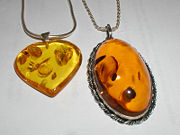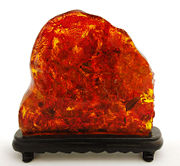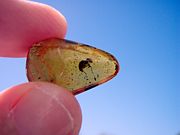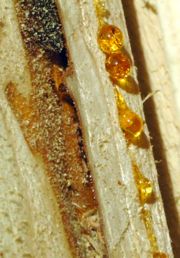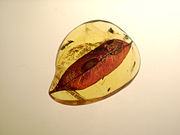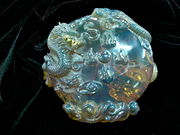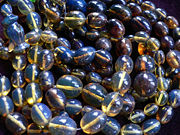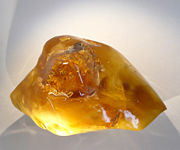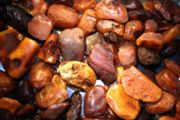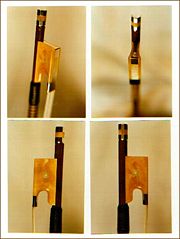Amber
2008/9 Schools Wikipedia Selection. Related subjects: Mineralogy
Amber is fossil resin, which is appreciated for its colour and beauty. Good quality amber is used for the manufacture of ornamental objects and jewellery. Although not mineralized, it is often classified as a gemstone.
A common misconception is that Amber is made of tree sap; it is not. Sap is the fluid that circulates through a plant's vascular system, while resin is the semi-solid amorphous organic substance secreted in pockets and canals through epithelial cells of the plant.
Most of the world's amber is in the range of 30–90 million years old. Because it used to be soft and sticky tree resin, amber can sometimes contain insects and even small vertebrates.
Semi-fossilized resin or sub-fossil amber is known as copal.
Amber occurs in a range of different colours. As well as the usual yellowy-orange that is associated with the colour "amber", amber itself can range from whitish through a pale lemon yellow to brown and almost black. There is also red amber (sometimes known as "cherry amber"), green amber, and even blue amber, which is rare and highly sought after.
A lot of the most highly prized amber is transparent, but cloudy amber and opaque amber is also common. Opaque amber contains numerous minute bubbles. This kind of amber is known as "bastard amber", even though it is a true amber.
Origin of the term
The English word amber stems from the old Arabic word anbargris or ambergris and refers to an oily, perfumed substance secreted by the sperm whale. Middle English ambre > Old French ambre > Medieval Latin ambra (or ambar). It floats on water and is washed up on the beaches. Due to a confusion of terms (see: Abu Zaid al Hassan from Siraf & Sulaiman the Merchant (851), Silsilat-al-Tawarikh (travels in Asia), it became to be the name for fossil resin or tree sap, which is also found on beaches, and which is lighter than stone, but not light enough to float.
The presence of insects in amber was noticed by the Pliny the Elder in his Naturalis Historia and led him to the (correct) theory that at some point, amber had to be in a liquid state to cover the bodies of insects. Hence he gave it the expressive name of suceinum or gum-stone, a name that is still in use today to describe succinic acid as well as succinite, a term given to a particular type of amber by James Dwight Dana (see below under Baltic Amber).
The Greek name for amber was ηλεκτρον (Electron) and was connected to the Sun God, one of whose titles was Elector or the Awakener. It is discussed by Theophrastus, possibly the first ever mention of the material, and in the 4th century BC. The modern term electron was coined in 1891 by the Irish physicist George Stoney, using the Greek word for amber (and which was then translated as electrum) because of its electrostatic properties and whilst analyzing elementary charge for the first time. The ending -on, common for all subatomic particles, was used in analogy to the word ion.
Heating amber will soften it and eventually it will burn, which is why in Germanic languages the word for amber is a literal translation of burn-Stone (In German it is Bernstein, in Dutch it is barnsteen etc.). Heated above 200°C, amber suffers decomposition, yielding an "oil of amber", and leaving a black residue which is known as "amber colophony", or "amber pitch"; when dissolved in oil of turpentine or in linseed oil this forms "amber varnish" or "amber lac".
Baltic amber has been extensively traded since antiquity. The Baltic and Slavonic terms for amber (e.g., lt: Gintaras; ru: Янтарь, yantar) are thought to originate from Phoenician jainitar (sea-resin).

Chemistry of amber
Amber is heterogeneous in composition, but consists of several resinous bodies more or less soluble in alcohol, ether and chloroform, associated with an insoluble bituminous substance. Amber is a macromolecule by free radical polymerization of several precursors in the labdane family, communic acid, cummunol and biformene. These labdanes are diterpenes (C20H32) and trienes which means that the organic skeleton has three alkene groups available for polymerization. As amber matures over the years, more polymerization will take place as well as isomerization reactions, crosslinking and cyclization. The average composition of amber leads to the general formula C10H16O.
Amber should be distinguished from copal. Molecular polymerisation caused by pressure and heat transforms the resin first into copal and then over time through the evaporation of turpenes it is transformed into amber.
Baltic amber is distinguished from the various other ambers from around the world, by the presence within it of succinic acid, hence Baltic amber is otherwise known as succinite.
Amber in geology
The oldest amber originates from the Upper Carboniferous period approximately 345 million years ago. The oldest known amber containing insects comes from the Lower Cretaceous, approximately 146 million years ago.
Commercially most important are the deposits of Baltic and Dominican amber. They both are of tertiary age (40-50 Ma respectively 25-40 Ma).
Baltic amber or succinite (historically documented as Prussian amber) is found as irregular nodules in a marine glauconitic sand, known as blue earth, occurring in the Lower Oligocene strata of Sambia in Kaliningrad Oblast, where it is now systematically mined. It appears, however, to have been partly derived from yet earlier Tertiary deposits (Eocene); and it occurs also as a derivative mineral in later formations, such as the drift. Relics of an abundant flora occur as inclusions trapped within the amber while the resin was yet fresh, suggesting relations with the flora of Eastern Asia and the southern part of North America. Heinrich Göppert named the common amber-yielding pine of the Baltic forests Pinites succiniter, but as the wood, according to some authorities, does not seem to differ from that of the existing genus it has been also called Pinus succinifera. It is improbable, however, that the production of amber was limited to a single species; and indeed a large number of conifers belonging to different genera are represented in the amber-flora.
Dominican amber is considered retinite, since it has no succinic acid. There are three main sites in the Dominican Republic: La Cordillera Septentrional, in the north, Bayaguana and Sabana, in the east. In the northern area, the amber-bearing unit is formed of clastic rocks, sandstone accumulated in a deltaic or even deep-water environment. The oldest, and hardest of this amber comes from the mountain region north of Santiago area, from the mines at La Cumbre, La Toca, Palo Quemado, La Bucara, and Los Cacaos mining sites in the Cordillera Septentrional not far from Santiago. Amber in these mountains is tightly embedded in a lignite layer of sandstone.
There is also amber in the south-eastern Bayaguana/Sabana area. It is softer, sometimes brittle and suffers oxidation after being taken from the mines, therefore less expensive. There is also copal found with only an age of 15-17 million years. In the eastern area, the amber is found in a sediment formation of organic-rich laminated sand, sandy clay, intercalated lignite as well as some solated beds of gravel and calcarenite.
Both, Baltic and Dominican amber, are rich sources of fossils and give much information about life in the ancient forests.
Amber from the Middle Cretaceous is known from Ellsworth County, Kansas. This approximately 100 million year old amber has inclusions of bacteria and amoebae. They are morphologically very close to Leptothrix, and the modern genera Pontigulasia and Nebela. Morphological stasis is considered to be confirmed.
Amber inclusions
The resin contains, in addition to the beautifully preserved plant-structures, remains of insects, spiders, annelids, frogs, crustaceans and other small organisms which were trapped by the sticky surface and became enveloped while the exudation was fluid. In most cases the organic structure has disappeared, leaving only a cavity, with perhaps a trace of chitin. Even hair and feathers have occasionally been represented among the enclosures. Fragments of wood frequently occur, with the tissues well-preserved by impregnation with the resin; while leaves, flowers and fruits are occasionally found in marvelous perfection. Sometimes the amber retains the form of drops and stalactites, just as it exuded from the ducts and receptacles of the injured trees. It is thought that, in addition to exuding onto the surface of the tree, amber resin also originally flowed into hollow cavities or cracks within trees, thereby leading to the development of large lumps of amber of irregular form. The abnormal development of resin has been called succinosis. Impurities are quite often present, especially when the resin dropped on to the ground, so that the material may be useless except for varnish-making, whence the impure amber is called firniss. Enclosures of pyrites may give a bluish colour to amber. The so-called black amber is only a kind of jet. Bony amber owes its cloudy opacity to minute bubbles in the interior of the resin.
Not all amber is translucent, becoming transparent when the surfaces are polished, thus revealing inclusions. The technique of inspecting darkly clouded and even opaque amber for inclusions, through bombarding it with high-energy, high-contrast, high-resolution x-rays, is being developed at the European Synchrotron Radiation Facility. Nearly 360 fossil invertebrates have been discovered from opaque amber found at Charentes, France: primitive wasps, flies, ants and spiders, particularly those measuring just a few millimeters. Three-dimensional images of the trapped organisms are built up through microtomography, showing detail on the scales of micrometres. An enlarged plastic three-dimensional model can be obtained of an organism that has remained embedded in the amber, suggesting alternative means of cataloguing new species trapped in amber.
Amber locations
Baltic amber
Baltic amber has a very wide distribution, extending over a large part of northern Europe and occurring as far east as the Urals.
Baltic amber yields on dry distillation succinic acid, the proportion varying from about 3% to 8%, and being greatest in the pale opaque or bony varieties. The aromatic and irritating fumes emitted by burning amber are mainly due to this acid. Baltic amber is distinguished by its yield of succinic acid, hence the name succinite proposed by Professor James Dwight Dana, and now commonly used in scientific writings as a specific term for the Prussian amber. Succinite has a hardness between 2 and 3, which is rather greater than that of many other fossil resins. Its specific gravity varies from 1.05 to 1.10. An effective tool for Baltic amber analysis is IR spectroscopy. It enables the distinction between Baltic and non-Baltic amber varieties because of a specific carbonyl absorption and it can also detect the relative age of an amber sample. On the other hand, it has been suggested by scientists that succinic acid is no original component of amber, but a degradation product of abietic acid. (Rottlaender, 1970)
Although amber is found along the shores of a large part of the Baltic Sea and the North Sea, the great amber-producing country is the promontory of Sambia, now part of Russia. About 90% of the world's extractable amber is located in the Kaliningrad region of Russia on the Baltic Sea. Pieces of amber torn from the seafloor are cast up by the waves, and collected at ebb-tide. Sometimes the searchers wade into the sea, furnished with nets at the end of long poles, which they drag in the sea-weed containing entangled masses of amber; or they dredge from boats in shallow water and rake up amber from between the boulders. Divers have been employed to collect amber from the deeper waters. Systematic dredging on a large scale was at one time carried on in the Curonian Lagoon by Messrs Stantien and Becker, the great amber merchants of Königsberg. At the present time extensive mining operations are conducted in quest of amber. The pit amber was formerly dug in open works, but is now also worked by underground galleries. The nodules from the blue earth have to be freed from matrix and divested of their opaque crust, which can be done in revolving barrels containing sand and water. The sea-worn amber has lost its crust, but has often acquired a dull rough surface by rolling in sand.
Since the establishment of the Amber Road, amber (which is also commonly referred to as the "Lithuanian gold") has substantially contributed to Lithuanian economy and culture. Nowadays amber jewellery and amberware is offered to foreign tourists in most souvenir shops as distinctive to Lithuania and its cultural heritage. The Amber Museum has been established in Palanga, near the sea coast. Amber can also be found in Latvia.
Dominican Amber
Since the book and movie Jurassic Park, Dominican amber has become world famous. Dominican amber differentiates itself from Baltic amber by being mostly transparent, and has a higher number of fossil inclusions. This has enabled the detailed reconstruction of the ecosystem of a long-vanished tropical forest. Resin from the extinct species Hymenaea protera is the source of Dominican amber and probably of most amber found in the tropics. It is not " succinite" but " retinite". In contrast to much Baltic amber, Dominican amber found on the world market is natural amber the way it comes from the mines, and has not been enhanced or received any chemical or physical change. The age of Dominican amber is around 40 million years.
Although all Dominican amber is fluorescent, the rarest Dominican Amber is Blue amber. It turns blue in natural sunlight and any other light source that has a slight component of UV (Ultra Violet). In long-wave UV light it has a very strong reflection, almost white. Only about 100 kilos of this fossilized tree is found per year, which makes it valuable and expensive.
Dominican Amber, and especially Dominican blue amber is mined through bell pitting, which is extremely dangerous. Bell pitting is basically a foxhole dug with whatever tools are available. Machetes do the start, some shovels, picks and hammers may participate eventually. The pit itself goes as deep as possible or safe, sometimes vertical, sometimes horizontal, but never level. It snakes into hill sides, drops away, joins up with others, goes straight up and pops out elsewhere. Rarely are the pits large enough to stand in, and then only at the entrance. Miners crawl around on their knees using short-handled picks, shovels and machetes. The amber that is found is either directly sold as rough or raw pieces or cut and polished without any additional treatments or enhancements.
The most common use for Dominican Amber is as ornaments and jewellery, while the more valuable enclosures and colorations become priced exhibition pieces both in private and public collections. In Far East, Blue Amber has been masterfully worked into artistic carvings. Others have used Blue Amber to make jewellery that can be especially attractive for its natural fluorescence under UV lights. In the Muslim world Dominican Amber and particularly Blue Amber beads have found their way into another use as worry beads, since Dominican Amber can very easily be worked.
Other locations
Amber deposits are found around the world. Some are much older than the well known amber deposits in the Baltic countries and the Dominican Republic, others are much younger. Some amber is considered to be up to 345 million years old (Northumberland USA).
A lesser known source of amber is in the Ukraine, within a marshy forested area on the Volyhn-Polesie border. Due to the shallow depth at which this amber is found it can be extracted with the simplest of tools, and has hence led to an economy of 'amber poaching' under cover of the forest. This Ukrainian amber has a wide range of colours, and was used in the restoration of 'amber room' in the Empress Catherines palace in St Petersberg (see below).
Rolled pieces of amber, usually small but occasionally of very large size, may be picked up on the east coast of England, having probably been washed up from deposits under the North Sea. Cromer is the best-known locality, but it occurs also on other parts of the Norfolk coast, such as Great Yarmouth, as well as Southwold, Aldeburgh and Felixstowe in Suffolk, and as far south as Walton-on-the-Naze in Essex, whilst northwards it is not unknown in Yorkshire. On the other side of the North Sea, amber is found at various localities on the coast of the Netherlands and Denmark. On the shores of the Baltic it occurs not only on the German and Polish coast but in the south of Sweden, in Bornholm and other islands, and in southern Finland. Some of the amber districts of the Baltic and North Sea were known in prehistoric times, and led to early trade with the south of Europe through the Amber Road. Amber was carried to Olbia on the Black Sea, Massilia (today Marseille) on the Mediterranean, and Adria at the head of the Adriatic; and from these centres it was distributed over the Ancient Greek world.
Amber is found in Switzerland, Austria and France. Amber from the Swiss Alps is about 55 - 200 million years old, amber from Golling about 225 - 231 million years. The well-known Sicilian Amber (Simetit - copal) is just 10 - 20 million years old.
In Africa, copal is found in the coastal countries of East and West Africa, but especially on Madagascar. This so-called Madagascar Amber is only 1,000 - 10,000 years old and consists of the solidified resin of the amber pine. Nigeria also has amber, which is about 60 million years old.
In Asia amber can be found especially in Burma (former Burma / Myanmar) as Burmit. It is about 50 million years and the Lebanon amber 130 - 135 million years old. Amber of the Australian-oceanic area can be found in New Zealand and Borneo (Sawak amber). They are about 20 - 60, part 70 - 100 million years old.
Amber is also found to a limited extent in the United States, as in the green-sand of New Jersey, but it has little economic value. Middle Cretaceous amber has also been found in Ellsworth County, Kansas. It has little value for jewelry makers, but is very valuable to biologists. The source of this amber is under a man-made lake.
A fluorescent amber occurs also in the southern state of Chiapas in Mexico, and is used for eye-catching jewellery. In Central America, the Olmec civilization was mining amber around 3000 B.C. There are legends in Mexico that mention the use of amber in adorning, consuming and using it for stress reduction as a natural remedy.
Indonesia is also a rich source of amber with large fragments being unearthed in both Java and Bali.
Amber treatments
The Vienna amber factories which use pale amber to manufacture pipes and other smoking tools, turn it on a lathe and polish it with whitening and water or with rotten stone and oil. The final lustre is given by friction with flannel.
When gradually heated in an oil-bath, amber becomes soft and flexible. Two pieces of amber may be united by smearing the surfaces with linseed oil, heating them, and then pressing them together while hot. Cloudy amber may be clarified in an oil-bath, as the oil fills the numerous pores to which the turbidity is due. Small fragments, formerly thrown away or used only for varnish, are now used on a large scale in the formation of "ambroid" or "pressed amber". The pieces are carefully heated with exclusion of air and then compressed into a uniform mass by intense hydraulic pressure; the softened amber being forced through holes in a metal plate. The product is extensively used for the production of cheap jewellery and articles for smoking. This pressed amber yields brilliant interference colors in polarized light. Amber has often been imitated by other resins like copal and kauri, as well as by celluloid and even glass. Baltic amber is sometimes colored artificially, but also called "true amber".
Often amber (particularly with insect inclusions) is counterfeited using a plastic resin. A simple test consists of touching the object with a heated pin and determining if the resultant odour is of wood resin. If not, the object is counterfeit, although a positive test may not be conclusive owing to a thin coat of real resin. Often counterfeits will have a too perfect pose and position of the trapped insect.
Amber art and ornament
Amber was much valued as an ornamental material in very early times. It has been found in Mycenaean tombs; it is known from lake-dwellings in Switzerland, and it occurs with Neolithic remains in Denmark, whilst in England it is found with interments of the bronze age. A cup turned in amber from a bronze-age barrow at Hove is now in the Brighton Museum. Beads of amber occur with Anglo-Saxon relics in the south of England. Amber was valued as an amulet and it is still believed to possess medicinal properties.
Amber is used for beads and ornaments, and for cigar-holders and the mouth-pieces of pipes. It is regarded by the Turks as specially valuable, inasmuch as it is said to be incapable of transmitting infection as the pipe passes from mouth to mouth. The variety most valued in the East is the pale straw-colored, slightly cloudy amber. Some of the best qualities are sent to Vienna for the manufacture of smoking appliances.
The Amber Room was a collection of chamber wall panels commissioned in 1701 for the king of Prussia, then given to Tsar Peter the Great. The room was hidden in place from invading Nazi forces in 1941, who upon finding it in the Catherine Palace, disassembled it and moved it to Königsberg. What happened to the room beyond this point is unclear, but it may have been destroyed when the Russians burned the German fortification where it was stored. It is presumed lost. It was re-created in 2003.
Amber has also been used to create the "frog" part of a Violin bow. It was commissioned by Gennady Filimonov and made by the late American Master Bowmaker Keith Peck
